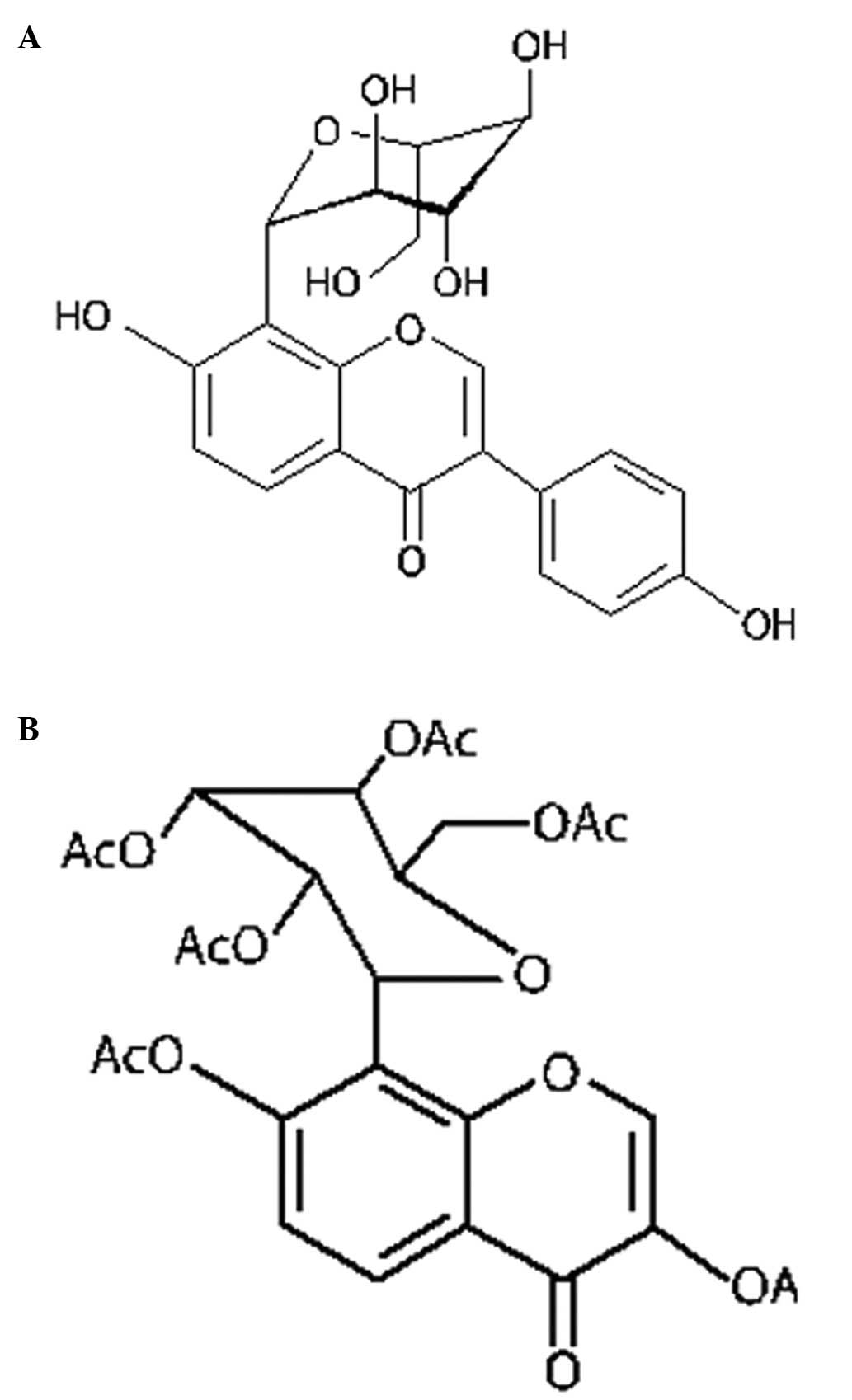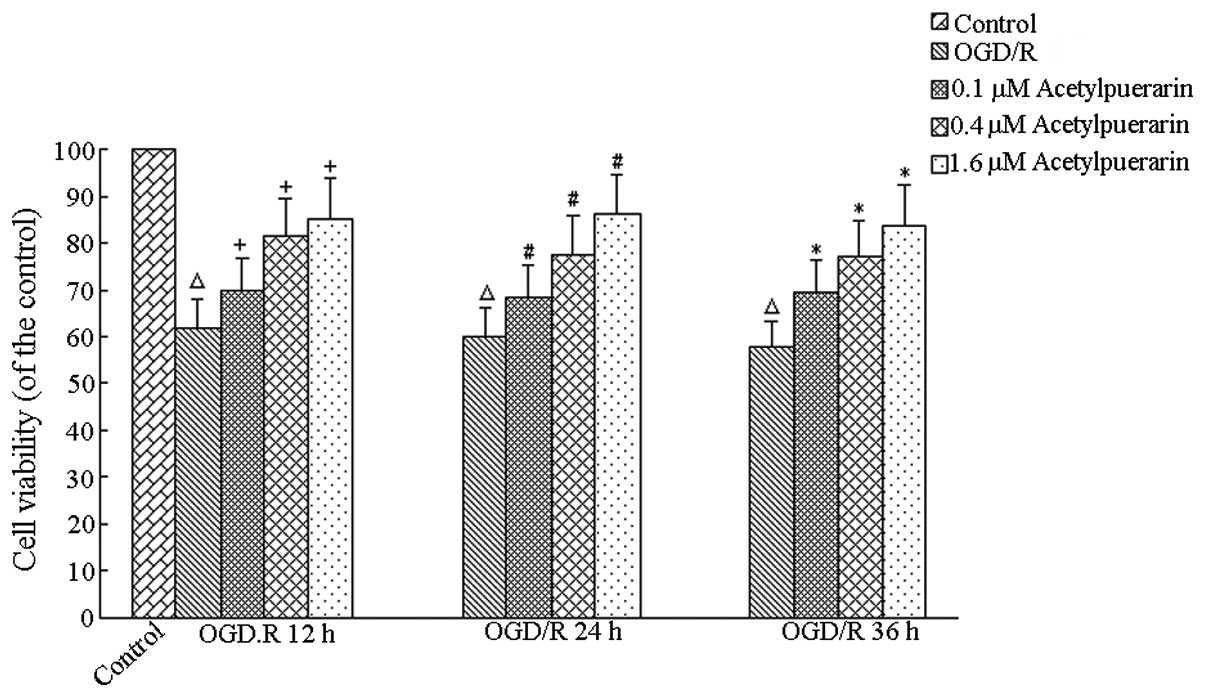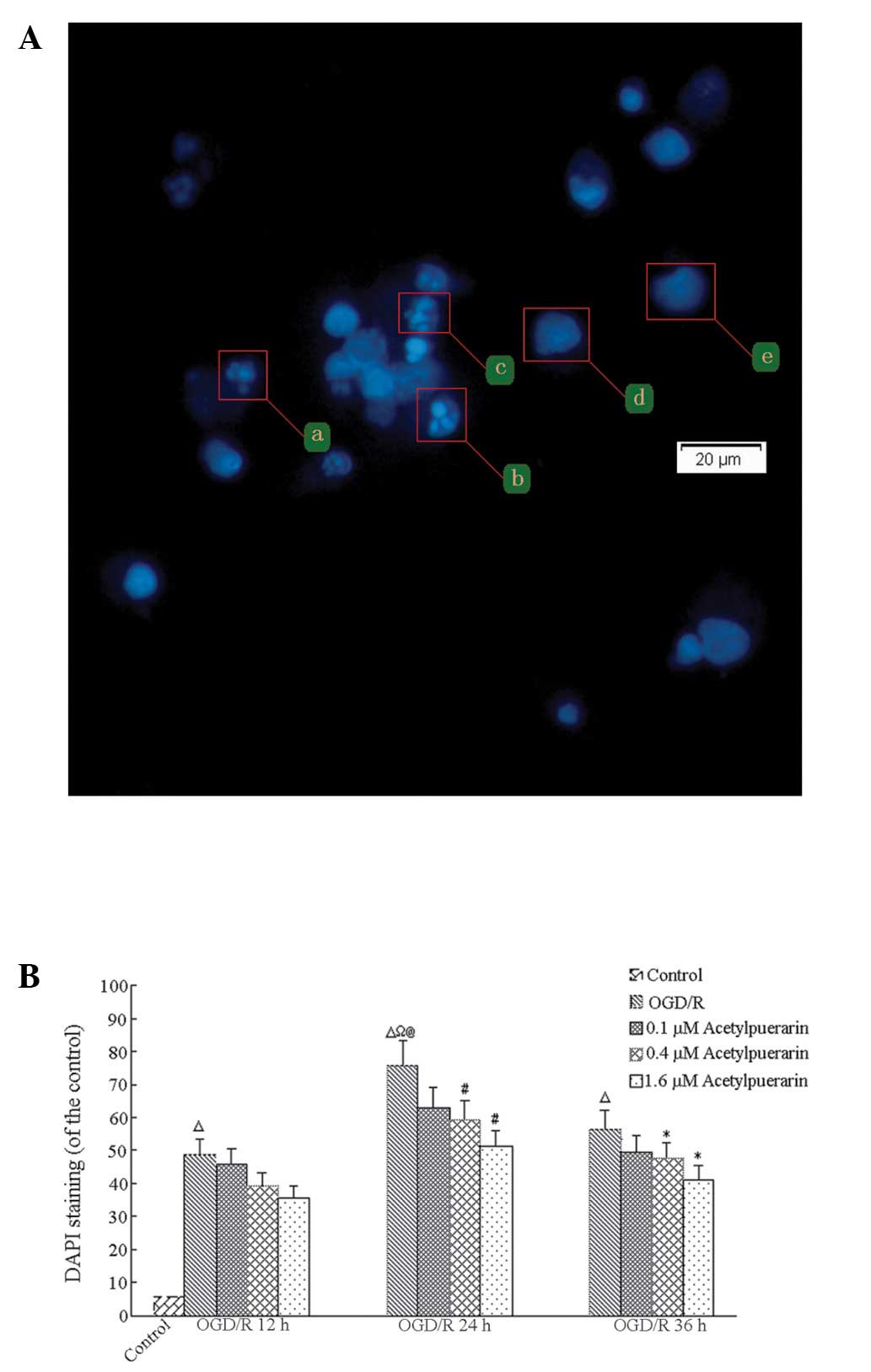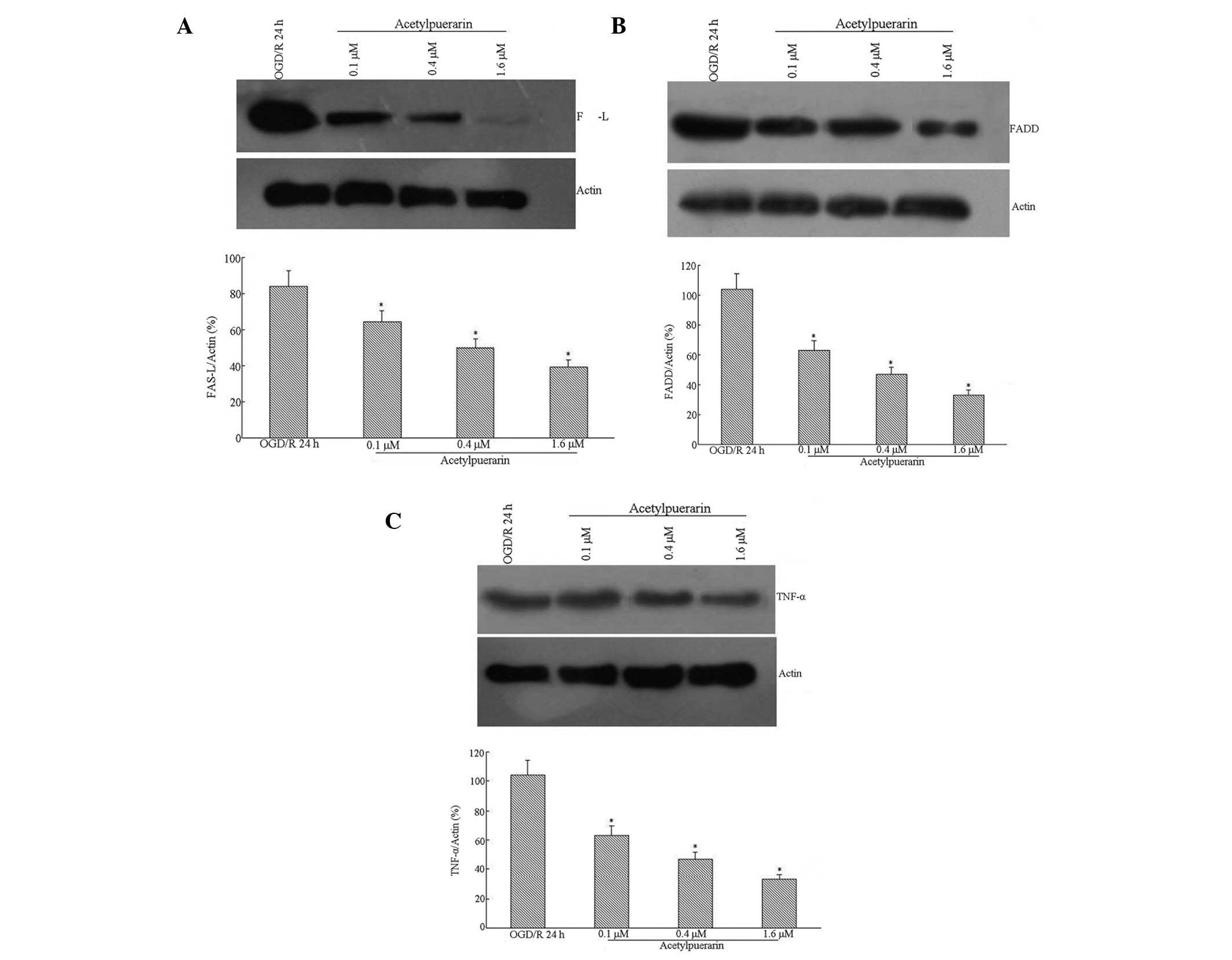|
1
|
Truelsen T, Begg S and Mathers C: The
global burden of cerebrovascular disease. Global Burden of Disease
2000. World Health Organization; Geneva: 2000
|
|
2
|
Zhao DX, Feng J, Cong SY and Zhang W:
Association of E-selectin gene polymorphisms with ischemic stroke
in a Chinese Han population. J Neurosci Res. 90:1782–1787. 2012.
View Article : Google Scholar : PubMed/NCBI
|
|
3
|
Wise-Faberowski L, Raizada MK and Sumners
C: Oxygen and glucose deprivation-induced neuronal apoptosis is
attenuated by halothane and isoflurane. Anesth Analg. 93:1281–1287.
2001. View Article : Google Scholar : PubMed/NCBI
|
|
4
|
Lu Y, Zhang J, Ma B, et al: Glycine
attenuates cerebral ischemia/reperfusion injury by inhibiting
neuronal apoptosis in mice. Neurochem Int. 61:649–658. 2012.
View Article : Google Scholar : PubMed/NCBI
|
|
5
|
Liu R, Wei XB and Zhang XM: Effects of
acetylpuerarin on hippocampal neurons and intracellular free
calcium subjected to oxygen-glucose deprivation/reperfusion in
primary culture. Brain Res. 1147:95–104. 2007. View Article : Google Scholar : PubMed/NCBI
|
|
6
|
No authors listed. Tissue plasminogen
activator for acute ischemic stroke. The National Institute of
Neurological Disorders and Stroke rt-PA Stroke Study Group. N Engl
J Med. 333:1581–1587. 1995. View Article : Google Scholar : PubMed/NCBI
|
|
7
|
Elijovich L and Chong JY: Current and
future use of intravenous thrombolysis for acute ischemic stroke.
Curr Atheroscler Rep. 12:316–321. 2010. View Article : Google Scholar : PubMed/NCBI
|
|
8
|
Wardlaw JM, Warlow CP and Counsell C:
Systematic review of evidence on thrombolytic therapy for acute
ischaemic stroke. Lancet. 350:607–614. 1997. View Article : Google Scholar : PubMed/NCBI
|
|
9
|
Hou L, Wei XB, Li XM, Zhong Y, Zuo CX and
Zhang XM: Protective effects of acetylpurarin on focal brain
ischemia-reperfusion injury in rats. Chin Pharm J. 42:1469–1472.
2007.(In Chinese).
|
|
10
|
Tan Y, Liu M and Wu B: Puerarin for acute
ischemic stroke. Cochrane Database Syst Rev.
2008:CD0049552008.PubMed/NCBI
|
|
11
|
Wu B, Liu M, Liu H, et al: Meta-analysis
of traditional Chinese patent medicine for ischemic stroke. Stroke.
38:1973–1979. 2007. View Article : Google Scholar : PubMed/NCBI
|
|
12
|
Xu X, Zhang S, Zhang L, Yan W and Zheng X:
The neuroprotection of puerarin against cerebral ischemia is
associated with the prevention of apoptosis in rats. Planta Med.
71:585–591. 2005. View Article : Google Scholar : PubMed/NCBI
|
|
13
|
Hou L, Zhang XM and Wei XB: Protective
effects of Compounds N-2211 on focal brain ischemia-reperfusion
injury in rats. Qilu Pharm Affairs. 23:52–54. 2004.(In
Chinese).
|
|
14
|
Li XM, Wei XB, Zhang XM, Hou L, Zhong Y
and Zuo CX: Effect of acetylpuerarin on NO level and NOS activity
in brain tissue and serum of focal cerebral ischemia reperfusion
injury rats. Chin Pharm J. 11:829–832. 2005.
|
|
15
|
Lou HY, Wei XB, Zhang B, Sun X and Zhang
XM: Hydroxyethylpuerarin attenuates focal cerebral
ischemia-reperfusion injury in rats by decreasing TNF-alpha
expression and NF-kappaB activity. Yao Xue Xue Bao. 42:710–715.
2007.PubMed/NCBI
|
|
16
|
Yao YY, Liu DM, Xu DF and Li WP: Memory
and learning impairment induced by dexamethasone in senescent but
not young mice. Eur J Pharmacol. 574:20–28. 2007. View Article : Google Scholar : PubMed/NCBI
|
|
17
|
Ziu M, Fletcher L, Rana S, Jimenez DF and
Digicaylioglu M: Temporal differences in microRNA expression
patterns in astrocytes and neurons after ischemic injury. PLoS One.
6:e147242011. View Article : Google Scholar : PubMed/NCBI
|
|
18
|
Sreelatha A, Jeyachitra A and Padma PR:
Antiproliferation and induction of apoptosis by Moringa
oleifera leaf extract on human cancer cells. Food Chem Toxicol.
49:1270–1275. 2011. View Article : Google Scholar
|
|
19
|
Badiola N, Malagelada C, Llecha N, et al:
Activation of caspase-8 by tumour necrosis factor receptor 1 is
necessary for caspase-3 activation and apoptosis in oxygen-glucose
deprived cultured cortical cells. Neurobiol Dis. 35:438–447. 2009.
View Article : Google Scholar : PubMed/NCBI
|
|
20
|
Yao H, Takasawa R, Fukuda K, et al: DNA
fragmentation in ischemic core and penumbra in focal cerebral
ischemia in rats. Brain Res Mol Brain Res. 91:112–118. 2001.
View Article : Google Scholar : PubMed/NCBI
|
|
21
|
Barone FC and Feuerstein GZ: Inflammatory
mediators and stroke: new opportunities for novel therapeutics. J
Cereb Blood Flow Metab. 19:819–834. 1999. View Article : Google Scholar : PubMed/NCBI
|
|
22
|
Jiang Y, Wu J, Keep RF, Hua Y, Hoff JT and
Xi G: Hypoxia-inducible factor-1alpha accumulation in the brain
after experimental intracerebral hemorrhage. J Cereb Blood Flow
Metab. 22:689–696. 2002. View Article : Google Scholar
|
|
23
|
Chen G and Goeddel DV: TNF-R1 signaling: a
beautiful pathway. Science. 296:1634–1635. 2002. View Article : Google Scholar : PubMed/NCBI
|
|
24
|
Liu L, Kim JY, Koike MA, et al: FasL
shedding is reduced by hypothermia in experimental stroke. J
Neurochem. 106:541–550. 2008. View Article : Google Scholar : PubMed/NCBI
|
|
25
|
Ruan W, Lee CT and Desbarats J: A novel
juxtamembrane domain in tumor necrosis factor receptor superfamily
molecules activates Rac1 and controls neurite growth. Mol Biol
Cell. 19:3192–3202. 2008. View Article : Google Scholar
|
|
26
|
Ashkenazi A and Dixit VM: Death receptors:
signaling and modulation. Science. 281:1305–1308. 1998. View Article : Google Scholar : PubMed/NCBI
|
|
27
|
Luo X, Budihardjo I, Zou H, Slaughter C
and Wang X: Bid, a Bcl2 interacting protein, mediates cytochrome
c release from mitochondria in response to activation of
cell surface death receptors. Cell. 94:481–490. 1998. View Article : Google Scholar : PubMed/NCBI
|
|
28
|
Varfolomeev EE and Ashkenazi A: Tumor
necrosis factor: an apoptosis JuNKie? Cell. 116:491–497. 2004.
View Article : Google Scholar : PubMed/NCBI
|
|
29
|
Garrido C, Gurbuxani S, Ravagnan L and
Kroemer G: Heat shock proteins: endogenous modulators of apoptotic
cell death. Biochem Biophys Res Commun. 286:433–442. 2001.
View Article : Google Scholar : PubMed/NCBI
|













